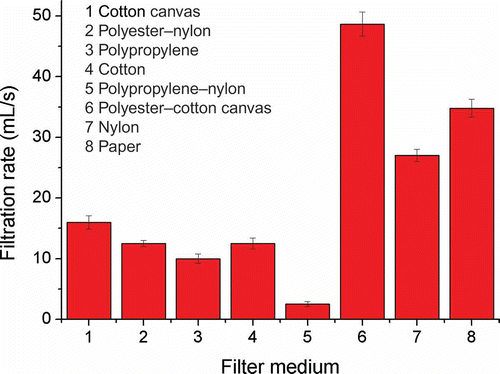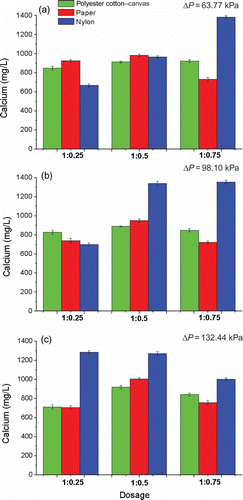Abstract
Nejayote is a nixtamalization waste by-product, and for this reason, in this study, filtration cakes as well as filtrate nejayote were evaluated to select the filter medium and also to establish the operation conditions. The different media used as filters at constant pressure filtrations were polyester–cotton canvas, paper, and nylon. The filtrations showed that polyester–cotton canvas presents lower specific resistance of the cake at all pressure levels and dosages. Calcium content was less in filter medium nylon at pressure 98.10 kPa and dosage 1:0.25 nejayote/diatomaceous earth. Regarding particle diameter, the nylon and paper filter media have the highest quality filtering at pressure of 63.77 kPa and dosage 1:0.25 nejayote/diatomaceous earth. Therefore, the filtration depends not only on the particle diameter of the solids, dosage and nejayote cake morphology, but that the filter media is also important in the selection of the operation conditions.
El nejayote es un subproducto contaminante de la nixtamalización, por lo que en este estudio se obtuvieron tortas de filtración y filtrados que fueron evaluados para seleccionar el medio filtrante y establecer condiciones de filtración. Los medios filtrantes empleados en la filtración a presión constante fueron: lona poliéster algodón, papel y nylon. Las filtraciones evidenciaron que la lona poliéster algodón presenta menor resistencia específica de la torta en todos los niveles de presión y dosificación. El contenido de calcio fue menor en el medio filtrante nylon a la presión 98,10 kPa y dosificación 1:0,25 nejayote/tierra diatomea. Respecto al diámetro de partícula los medios filtrantes nylon y papel dan una mayor calidad de filtrado a la presión 63,77 kPa y dosificación 1:0,25 nejayote/tierra diatomea. En consecuencia, la filtración no sólo depende del diámetro de partícula de los sólidos, dosificación y morfología de la torta de nejayote, también el medio filtrante es determinante en la selección de las condiciones de operación.
Keywords:
Palabras claves:
Introduction
The nixtamalization process is important in Mexico and in some other countries of Central America, the United States of America, Asia, and Europe, due to the calcium bioavailability added during the process (Almeida-Domínguez, Cepeda, & Rooney, Citation1996). Traditional nixtamalization is the basis of commercial methods of the production of tortillas and a large variety of corn snacks and typical Mexican products such as tamales, gorditas, chilaquiles, tostadas, and tacos (Gutiérrez et al., Citation2007; Rojas-Molina et al., Citation2008).
Nixtamalization in a very important process, because it improves the nutritional characteristics of the corn due to the increment in the calcium content in the final products. Interaction among calcium and different compounds of the grain determines physicochemical and sensory properties of the products such as masa, tortillas, and instants flours. During nixtamalization, the cells walls of corn grains are solubilized; in consequence, some fractions of pericarp are removed. Subsequently, a portion of calcium remains is disposed in the supernatant called Nejayote (Rojas-Molina et al., Citation2009).
Nejayote is a highly polluting waste liquid that contains an elevated soluble and insoluble particles concentration. Pflugfelder, Roony, and Waniska (Citation1988) reported that nejayote contains soluble and insoluble solids such as polysaccharides, starch, fiber and protein. In consequence, nejayote obtained from nixtamalization is considered to be a polluting waste liquid for the environment due to its chemical composition. Valderrama-Bravo et al. (Citation2012) reported high values of biologic oxygen demand (DBO5) (14,219 ± 309 mg/L), total suspended solids (8342 ± 25 mg/L), chemical oxygen demand (DQO) (40,058 ± 82 mg O2/L), and total alkalinity (5768 ± 0.5 mg/L CaCO3). However, these authors performed nejayote filtration and the results showed decreases of DBO5, DQO, hardness levels and total solids to 140 ± 8 mg/L.
A number of technologies are available with varying degree of success to control water pollution. Some of them are coagulation, foam flotation, ion exchange, aerobic and anaerobic treatment, advanced oxidation processes, solvent extraction, desorption, electrolysis, microbial reduction, and activated sludge. However, most of these require substantial financial input and their use is restricted because of cost factors overriding the importance of pollution control (Amit & Mika, Citation2010). Furthermore, these methods are not alternatives to reusing waste water because the objective is to obtain potable water and to eliminate solids. Therefore in Mexico, it is necessary to find alternatives to reuse nejayote; consequently, physico-mechanical separation methods such as filtration, used in a preliminary stage, gives important results for the reuse of these kinds of wastes. Filtration is a dynamic process of fine particles that involves filter cake formation, which is defined as a bed of particles with a complex system of interconnected empty particles (Lin & Miller, Citation2000b). The use of cake filtration is widespread in many of the chemical, food, brewing, ceramic, and mineral processing industries. Within these areas, the objective of filtration may be to recover a clear filtrate, to recover the suspended solids, or, in some cases, to recover both the solids and the filtrate (Tarleton & Willmer, Citation1997). Valderrama-Bravo et al. (Citation2012) performed filtration with nejayote, using diatomaceous earth (diatomite) as filter aid. The results indicated that the nejayote turbidity without precoat is higher than when the precoat was used. This observation indicates that filtration is more efficient when a filter aid is used as precoat. The reduction in the turbidity of the filtrate nejayote is to the elimination of a greater amount of solids. Subsequently, filtrate nejayote will have the highest quality filtering.
The Darcy law serves as the main equation for the formulation of filtration equations. This law is an empirical equation that describes the one-dimensional fluid flow through a uniform incompressible porous medium (Svarovsky, Citation1990). Ruth, Montillon, and Montonna (Citation1933) and Ruth (Citation1935) developed the classical filtration theory based on the Darcy law, which performed a material balance. Likewise, these authors considered analogy with Ohm'law for two resistances in serial, the cake resistance and the filter medium resistance. Therefore, obtained equation is a general equation for filtration:
Equation (1) has served as a basis for interpreting laboratory tests and for developing design equations for constant pressure and constant rate (Hosten, Citation1993).
The purpose of this research was to evaluate the specific resistance of cake, calcium contains, and average particle diameter, in order to select the filter medium and establish the best operation conditions for nejayote pretreatment.
Methodology
Sample collection
Nejayote samples were obtained in a nixtamalization traditional mill. In order to have more control over the samples and process conditions, nejayote was stored in containers of 20 L at 4°C.
Morphology in nejayote solids and filter media
In order to show the relationship between the size of the particles of the nejayote solids and the pore size of the filter media, nejayote solids morphology and the filter media polyester–cotton canvas, paper, and nylon were analyzed by high vacuum scanning electronic microscopy (SEM). Samples were fixed on bronze brackets with graphite tape. The mounted samples were coated by sputtering with a thin gold film in order to make them conductive and submitted to three rotation cycles, each lasting 4 minutes. Then, samples were set and transferred at rail equipment and observed in the electronic microscopy JEOL JSM-GOGOLV (JEOL, Akishima, Tokyo, Japan) at 20 kV and 270 Pa of high vacuum.
Filterability tests
Filterability tests were performed with eight filter media in a Buchner funnel at 39.9 kPa. The test consists in to filter 100 mL of nejayote and determines the final filtration time. The objective was to select three filter media based on the highest filtration rate values.
Filtration in cell
Precoat with thickness of 3.17 mm was formed with diatomite to avoid saturation in filter medium channels. Methodology used was reported by Valderrama-Bravo et al. (Citation2012).
Filtration cell was designed and built in Multidisciplinary Laboratory, Facultad de Estudios Superiores Cuautitlán, UNAM, Mexico. Preliminary filtration tests were performed in filtration cell with nejayote at five pressures levels 29.43, 63.77, 98.10, 132.44, and 166.77 kPa. Data obtained were for filtration time versus volume. It was difficult to maintain a constant pressure of 29.43 kPa. Likewise, it was not possible to collect data with accuracy at a pressure of 166.77 kPa. Therefore, three selected pressures were used: 63.77, 98.10, and 132.44 kPa.
The diatomite dosage was varied in relation to solids contain nejayote at three levels 1:0.25, 1:0.50, and 1:0.75 nejayote/diatomite, based in dry weight (w/w). The dosage relation means that by 1 g of solids content in 100 mL of nejayote, it was necessary to add 1 g of diatomite and then mix them. The three filters media used were polyester–cotton canvas, paper, and nylon. Nejayote was mixed with a propel mixer model IKA WERKE EUROESTAR (IKA Works, Inc., Wilmington, NC).
Data of filtration time versus volume were obtained during filtration operation and the average of three measurements for each sample was reported.
Morphology of nejayote cakes
In order to study cake formation, it was obtained from filtration cell and retained on the filter media polyester–cotton canvas, paper, and nylon at dosages of 1:0.25 and 1:0.5 nejayote/diatomite and pressure 98.10 kPa. The structure and morphology of the final cake were analyzed by using SEM.
Determination of specific resistance of the cake
Toledo (Citation2007) proposed a model (EquationEquation (2)(2)) based on the general filtration equation (EquationEquation (1)
(1)):
Equation (2) is a model that serves to determine the specific resistance of the cake when the filtrations are performed with precoat.
The model of EquationEquation (2)(2) is modifying by applying square root:
Calcium determination
The calcium content of the filtrate samples was determined by atomic absorption spectrophotometry according to method AOAC 971.20 (1998). Pressure factors were 63.77, 98.10, and 132.44 kPa; dosages were 1:0.25, 1:0.5, and 1:0.75 nejayote/diatomite; and filter media were polyester–cotton canvas, paper, and nylon.
Average particle size diameter
Average particle diameter of the sample was obtained by particle-size distribution, which was determined using dynamic light scattering (DLS Brookhaven Instruments BI-APD, Holtsville, NY, USA), with range 1nm–6mm, red laser, 90° scattering angle, 25°C ambient temperature, and 5 s step time. Twenty milliliters of filtrate nejayote was stirred by hand at room temperature for 5 min. The first measurement was made immediately after stirring. Pressure factors were 63.77, 98.10, and 132.44 kPa; dosages were 1:0.25, 1:0.5, and 1:0.75 nejayote/diatomite; and filter media were polyester–cotton canvas, paper, and nylon.
Statistical analysis
One-way analysis of variance was performed using the StatGraphics Centurion XVI ANOVA software (Start Point Technologies, Inc., Addison, TX, USA) and applying the Tukey multiple range tests with a probability of P ≤ 0.5. The effects of pressure, dosage ratio, and filter medium were studied as factors.
Results
Morphology in nejayote solids and filter media
(a) shows the SEM micrograph obtained by nejayote solids (1000 ×). , and (d) shows the SEM micrographs of filter media polyester–cotton canvas, paper, and nylon, respectively. In , it is clear the presence of fibers, CaCO3 clusters (10 and 25 μm) as well as the starch granules of approximately 20 µm in diameter present in nejayote. The filter media used showed different pore sizes: polyester–cotton canvas 6–8 μm (), paper 16–18 μm (), and nylon 22–24 μm (). On the other hand, nejayote is a complex system due to the existence of a wide range of particles with different shapes and sizes, which are greater than the filter pore size (). In filtration operation the interaction between the pore size of the filter medium and the particle pore size is important. Also the microstructure and connectivity of the pore space are important to describing fluid flow in filter cake during particle filtration (Lin & Miller, Citation2000a).
Figure 1. (a) SEM image of nejayote solids (1000 ×) (b) SEM image of filter medium polyester–cotton canvas. (c) SEM image of filter medium paper. (d) SEM image of filter medium nylon.(a) Imagen de SEM de sólidos de nejayote a (b) Imagen de SEM del medio filtrante lona poliéster algodón (c) Imagen de SEM del medio filtrante papel (d) Imagen de SEM del medio filtrante nylon.
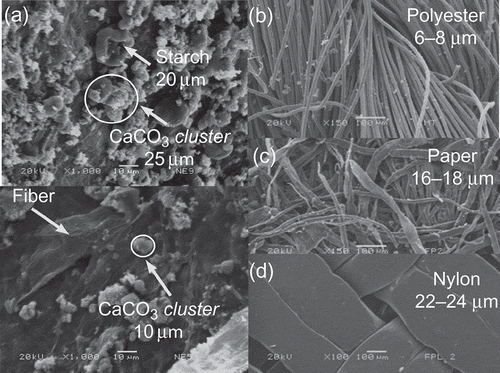
Filterability test
shows the histogram of the filtration rate versus filter media. Filter media that had a higher filtration rate were 6 (polyester–cotton canvas), 7 (nylon) and 8 (paper), which were selected for testing filtration.
Filtration cell
Taking into account the above findings, experiments were conducted in the filtration cell with a precoat thickness of 3.17 mm. This precoat thickness avoids saturation of the percolation channels; consequently, the total filtration time decreases drastically as it was reported by Valderrama-Bravo et al. (Citation2012).
Statistical analysis showed that the filtration time was significant (α = 0.00001) for the three independent variables, filter media, dosage, and pressure. Results of Tukey method showed that pressure significantly influences in all levels of filtering nejayote volume. Referring to the filtrating medium used, the polyester–cotton canvas showed the greatest significant difference on the volume of filtration obtained.
shows the graph of volume of filtrate nejayote as a function of the filtration time at a constant dosage 1:0.25 nejayote/diatomite for three different pressure levels. shows that the pressure increases a dosage 1:0.25 nejayote/diatomite; however, filtration time decreases. shows that the filtration time obtained of polyester–cotton canvas medium is approximately 6 times lower than the paper medium and three times lower than the nylon medium. In , corresponding to 98.10 kPa pressure, the filtration time decreases about 50% in the three media. However, to 132.44 kPa pressure, the filtration time in the media nylon and polyester–cotton canvas increases. Tiller and Hyun (Citation1998) mentioned that highly compressible in beds of fragile flocks or biosolids derived from municipal waste water, when the pressure exceeds about 1 atm, never increases the flow rate of filtrate. Accordingly, filtration times may be very long, which would mean that Darcy's law is not satisfied and the filters are ineffective since the filtrate volume obtained is lower.
Figure 3. Nejayote volume versus filtration time at dosage 1:0.25 nejayote/diatomite for three different pressures: (a) 63.77 kPa, (b) 98.10 kPa, and (c) 132.44 kPa.Volumen de nejayote en función del tiempo de filtración a dosificación 1:0,25 (a) Presión 63,77 kPa (b) Presión 98,10 kPa (c) Presión 132,44 kPa.
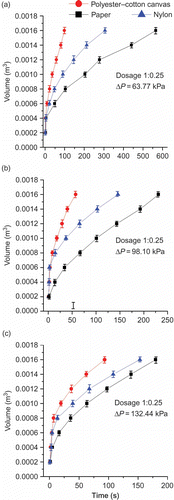
shows the graph of volume of filtrate nejayote versus filtration time at constant dosage 1:0.5 nejayote/diatomite for three pressure levels. Comparing , corresponding to the dosage 1:0.5 nejayote/diatomite, with the , at dosage 1:0.25 nejayote/diatomite, presents a strange behavior in filtration times. shows that with increasing pressure, filtration time decreases for filter media polyester–cotton canvas, and paper; however, for the nylon filter medium at lower pressure, filtration time decreases. This fact may be that during the cake formation the arrangement of the particles presents a stochastic behavior; consequently, the filtration times changes drastically. Lin and Miller (Citation2000b) reported that the particle bed of a filter cake seems to be organized randomly together with some accompanying segregation. The effect of deposited particles on collection efficiencies can be calculated using stochastic modeling of particle deposition (Tien, Citation1984).
Figure 4. Nejayote volume versus filtration time at dosage 1:0.5 nejayote/diatomite for three different pressures: (a) 63.77 kPa, (b) 98.10 kPa, and (c) 132.44 kPa.Volumen de nejayote en función del tiempo de filtración a dosificación 1:0,5 (a) Presión 63,77 kPa (b) Presión 98,10 kPa (c) Presión 132,44 kPa.
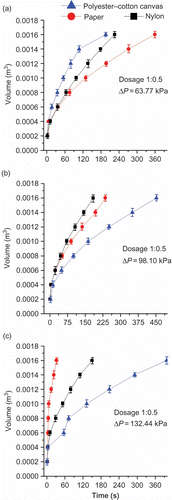
It was observed that the filter medium polyester–cotton canvas was showing the lower filtration times, at dosages of 1:0.25 nejayote/diatomite at the pressures 63.77, 98.10, and 132.44 kPa. However, for dosage 1:0.5 nejayote/diatomite, the media nylon, paper and polyester–cotton canvas obtained lower filtration times at the pressures 63.77, 98.10, and 132.44 kPa, respectively (). Valderrama-Bravo et al. (Citation2012) showed that a dosage of 1:0.5 nejayote/diatomite occurs due to different mechanisms in the particles’ arrangements during filtration, which influence filtration times. These authors mention that to 1:0.5 nejayote/diatomite, the percolation channels decrease in the vertical direction by forming clusters between diatomaceous earth and nejayote solids. However, the authors performed the analysis only to the filter medium polyester–cotton canvas.
(a) and (b) show filtration cakes at dosage 1:0.25 and pressure 98.10 kPa for polyester–cotton canvas and paper, respectively. and show filtration cakes at dosage 1:0.5 nejayote/diatomite and pressure 98.10 kPa for paper and nylon, respectively. These figures showed that the percolation channels are saturated by particles with the same dimensions as the channels of filtration media on the different operating conditions. demonstrates that at dosage of 1:0.25 nejayote/diatomite, the formed cake is a bed-packed compact, then percolation channels of paper are saturated more rapidly, since the filtration times are higher at all pressures (). Nevertheless, in the filter medium polyester–cotton canvas at dosage 1:0.25 nejayote/diatomite, filtration cake is more porous (); additionally, filtration times are lower at all pressure (). However, in the filter medium paper at dosage 1:0.5 nejayote/diatomite and pressure 98.10 kPa, filtration cake was more porous () than filtration cake obtained with nylon (). In addition, filtration depends not only particle diameter of the solids, dosage and morphology nejayote cake, the filter medium is also decisive in the selection of operating conditions, as mentioned by Yukseler, Tosun, and Yetis (Citation2007).
Figure 5. SEM images of filtration cakes (400 ×) at pressure 98.10 kPa: (a) dosage 1:0.25 nejayote/diatomite for polyester–cotton canvas, (b) dosage 1:0.25 nejayote/diatomite for paper, (c) dosage 1:0.5 nejayote/diatomite for paper, and (d) dosage 1:0.5 nejayote/diatomite for nylon.Imágenes de SEM de tortas de filtración (400 ×) a presión 98,10 kPa (a) Dosificación 1:0,25 nejayote/diatomea para lona poliéster algodón (b) Dosificación 1:0,25 nejayote/diatomea para papel (c) Dosificación 1:0,5 nejayote/diatomea para papel (d) Dosificación 1:0,5 nejayote/diatomea para nylon.

Determination of specific resistance of the cake
shows the results of the specific resistance of the cake versus dosage, for the three filter media. Statistical analysis showed a significant difference in the specific resistance of the cake for dosage (α = 0.0001), the filter media (α = 0.0002), and pressure (α = 0.001). The mean difference performed to dosage showed that the dosage of 1:0.75 nejayote/diatomite presented lower specific resistance of the cake.
Figure 6. Specific resistance of the cake versus dosage for three filter media: (a) pressure 63.77 kPa, (b) pressure 98.10 kPa, and (c) pressure 132.44 kPa.Resistencia específica de la torta en función de la dosificación para 3 medios filtrantes (a) Presión 63,77 kPa (b) Presión 98,10 kPa (c) Presión 132,44 kPa.
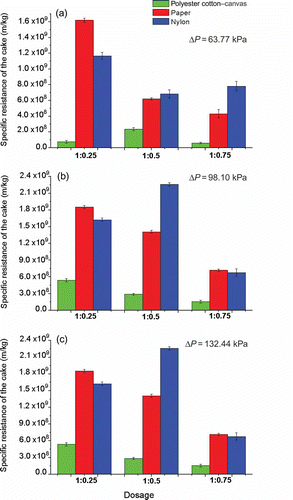
In polyester–cotton canvas, no significant difference was observed at pressure 63.77 kPa between dosages 1:0.25 and 1:0.75 (nejayote/diatomite).
shows that in polyester–cotton canvas, α increases at dosage 1:0.5 nejayote/diatomite and decreases in the filter media nylon, while shows that α increases in filter media polyester–cotton canvas and nylon. In the case of filter of paper, it does not exhibit this behavior because α value decreases with increasing dosage. Tosun, Yetis, Willis, and Chase (1993) found that α is highly dependent on particle size distribution of the slurry, type of filter medium, area filtration, and pressure. –() at dosage 1:0.5 showed less α in polyester–cotton canvas. These results are similar with the obtained by Yukseler et al. (Citation2007). They demonstrated the effect of particle size–pore size interaction with different filter media. Particles in the nejayote () are relatively greater than the pore size of filter medium polyester–cotton canvas (), then a decrease in α is observed (–), possibility due to lower blockage of the pores in the filter medium.
shows that at pressure of 132.44 kPa, polyester–cotton canvas presents changes in α, because its value decreases with increasing dosage. This phenomenon may be due to that the pressure increases, and then, there is a rapid transition of deformation of the particles, allowing that the particles exhibit a behavior incompressible during the cake formation. The general equation of filtration that comes from Darcy's law shows that increasing the pressure increases the value of α; however, this law is not enforced at all dosages. This fact may be due to two aspects: the first is that in some cases during treatment of waste water biosolids, cake compressibility is modified when pressure increases. Tiller and Hyun (Citation1998) reported a highly aggregated structure is easily compacted. Stress applied on filter cake causes a decrease in porosity, an increase in resistance to flow, and a decrease in permeability. Valdes-Parada, Ochoa-Tapia, and Alvarez-Ramirez (Citation2009) mentioned that some authors solved numerically the Navier–Stokes equation for random pore networks and showed that near the percolation threshold, scaling laws apply dependent flow conditions. This fact implies deviations from Darcy's law, restricting the application of the general equation of filtration. Second aspect is related to the dosage by mechanisms that occur between nejayote solids and diatomite. Structure diatomite is porous and permeable, when the nejayote solids cover the diatomite, resulting in the formation clusters. This reduces the formation of paths in the vertical direction, and the filtration rate decreases. Valderrama-Bravo et al. Citation2012 showed that the cake formation may be governed by two different events: the first is that the particles only form channel-like paths, and the second is that the particles form channel-like paths and clusters of diatomite mixed with nejayote solids simultaneously.
Calcium determination
shows the content of calcium (mg/L) versus dosage. Statistical analysis shows a significant difference in the calcium content for dosage (α = 0.0018) and the filter media (α = 0.00001), not so for the pressure. No significant difference between filter media paper and nylon at pressure 63.77 kPa and 98.10 kPa and at dosages 1:0.5 and 1:0.25 (nejayote/diatomite) was observed, respectively. At pressure of 132.44 kPa and dosage 1:0.25 (nejayote/diatomite), no significant difference between filter media paper and polyester–cotton canvas was observed. In nylon at pressure 98.10 kPa, the statistical analysis shows no significant difference between dosages 1:0.25 and 1:0.50 (nejayote/diatomite). In the same way, at pressure 132.44 kPa, no significant difference between dosages 1:0.25 and 1:0.5 (nejayote/diatomite) was showed. However, statistical analysis shows significant difference among the three filter media at dosage 1:0.75 for all the pressure levels. The mean analysis performed to dosage shows that the dosage of 1:0.25 nejayote/diatomite observed lower levels of calcium. With respect to the filter media, polyester–cotton canvas and paper showed lower calcium content at pressure of 132.44 kPa and dosage 1:0.25 nejayote/diatomite. and show that at pressures 63.77 and 98.10 kPa with the lowest dosage 1:0.25 nejayote/diatomite, calcium content is lower in the filter medium nylon. However, when increasing pressure (132.44 kPa), values calcium content increases in the filter media nylon. Valderrama-Bravo et al. (Citation2012) reported that calcium content in nejayote was 1525 mg/L, which decreases to 712 mg/L with the filter media polyester–cotton canvas at dosage of 1:0.25 nejayote/diatomite. However, it is not possible to eliminate soluble calcium content by filtration; therefore, it is necessary to apply a chemical treatment at filtrate nejayote to precipitate the insoluble calcium and remove by filtration. Furthermore, having a high calcium concentration in the filtrates could represent an alternative to controlling the degree of suppressive soils against organisms that attack roots of plants, such as A. auteiches (Heyman, Lindahl, Persson, Wikström, & Stenlid, Citation2007).
Average particle size diameter
shows the average diameter of particles (nm) in filtrates nejayote versus dosage. Statistical analysis showed significant difference in the particle diameters for dosage (α = 0.00001), filter media (α = 0.01230), and pressure (α = 0.0256). At pressure 63.77 and 132.44 kPa and dosage 1:0.25 (nejayote/diatomite), no significant difference between paper and nylon was showed, while at pressure 63.77 kPa and dosage 1:0.75 (nejayote/diatomite), no significant difference between nylon and polyester–cotton canvas was observed. At pressure 98.10 kPa and dosage 1:0.25 (nejayote/diatomite), the statistical analysis indicates no significant difference between filters of polyester–cotton canvas and nylon. At pressure 132.44 kPa and dosage 1:0.75 (nejayote/diatomite), no significant difference among paper, polyester–cotton canvas, and nylon was observed. On the other hand, statistical analysis shows significant difference among dosage 1:0.25, 1:0.5, and 1:0.75 nejayote/diatomite for all pressure levels. The mean analysis performed to dosage showed that for dosage of 1:0.25 nejayote/diatomite and pressure of 63.77 kPa, filter media nylon and paper present higher quality of filtering because the average diameter of particle was lowest. At dosage of 1:0.5 nejayote/diatomite and pressure of 63.77 kPa, filter medium paper showed higher quality of filtering because average particle diameter was lower.
Figure 8. Average particles diameter versus dosage for three filter media: (a) pressure 63.77 kPa, (b) pressure 98.10 kPa, and (c) pressure 132.44 kPa.Diámetro promedio de partículas en función de la dosificación para 3 medios filtrantes (a) Presión 63,77 kPa (b) Presión 98,10 kPa (c) Presión 132,44 kPa.
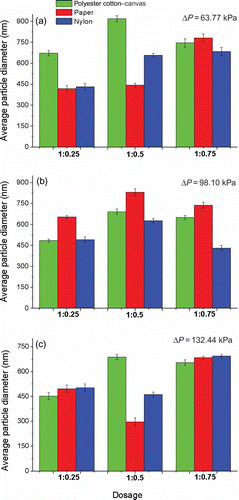
Analyzing graphics volume versus filtration time ( and ), specific resistance of the cake (), calcium content (), and average particle diameter () can be set operating conditions of the cell filtration. It is clear that the specific resistance lower cake was in the filter media polyester–cotton canvas. Filtration times are lower with filter medium polyester cotton-canvas and dosage 1:0.25 (nejayote/diatomite), but if the objective is to obtain filtrates with higher quality, then filter media paper and nylon are suitable to perform the filtration, although it involves a greater time in the operation.
Pressure level to operate the filtration cell was 98.10 kPa for filter medium polyester–cotton canvas, as reported by Valderrama-Bravo et al. (Citation2012). However, if objective is to decrease calcium content and to obtain filtrates with higher quality, at a pressure of 98.10 kPa and dosage of 1:0.25 nejayote/diatomite, the nylon filter medium is appropriate. Conversely, if purpose is to obtain a higher quality filtering, filter media nylon and paper must be used at a pressure of 63.77 kPa and dosage 1:0.25 nejayote/diatomite, while the pressure of 98.10 kPa and dosage 1:0.75 nejayote/diatomite filter medium nylon is appropriate.
Conclusions
This study showed that the percolation channels of the three filter media were saturated by particles of same dimensions as the channels to different operating conditions. Percolation channels of filter medium paper are saturated more rapidly, since the filtration times are greater in all the pressures at dosage of 1:0.25 nejayote/diatomite. However, the filter media polyester–cotton canvas has the opposite tendency. Consequently, filtration depends not only on particle diameter of the dosage, and morphology nejayote cake, but that the filter medium is also decisive in the selection of operating conditions. The results revealed that filter media polyester–cotton canvas, paper, and nylon may be used depending on the kind of filtrated to be desired during the filtration. It is clear that dosage 1:0.25 nejayote/diatomite is appropriate for filtering nejayote.
Acknowledgements
The authors thank the Department of Engineering and Technology (Multidisciplinary Experimental Laboratory) and Department of Mathematics, FES-Cuautitlán, UNAM, for infrastructure and administrative support.
References
- Almeida-Domínguez , H.D. , Cepeda , M. and Rooney , L.W. 1996 . Properties of commercial nixtamalized corn flours . Cereal Foods World , 41 : 624 – 630 .
- Amit , B. and Mika , S. 2010 . Utilization of agro-industrial and municipal waste materials as potential adsorbents for water treatment – A review . Chemical Engineering Journal , 157 : 277 – 296 .
- AOAC. (1998). Official methods of analysis of AOAC international (Method 968.08, 16th ed.). Gaithersburg, MD: AOAC.
- Gutiérrez , E. , Rojas-Molina , I. , Pons-Hernández , J.L. , Guzmán , H. , Aguas-Ángel , B. , Arenas , J. and Rodríguez , M.E. 2007 . Study of calcium ion diffusion in nixtamalized quality protein maize as a function of cooking temperature . Cereal Chemistry , 84 : 186 – 194 . …
- Heyman , F. , Lindahl , B. , Persson , L. , Wikström , M. and Stenlid , J. 2007 . Calcium concentrations of soil affect suppressiveness against . Aphanomyces , 39 : 2222 – 2229 . root rot of pea. Soil Biology & Biochemistry,
- Hosten , C. 1993 . Cake filtration rate equations a review of classical and modern approaches . Minerals Engineering , 6 : 775 – 783 .
- Lin , C. and Miller , J. 2000a . Network analysis of filter cake poro structure by high resolution X-ray microtomography . Chemical Engineering Journal , 77 : 79 – 86 .
- Lin , C. and Miller , J. 2000b . Pore structure and network analysis of filter cake . Chemical Engineering Journal , 80 : 221 – 231 .
- Pflugfelder , R.L. , Roony , L.W. and Waniska , R.D. 1988 . Dry matter losses in commercial corn masa production . Cereal Chemistry , 65 : 127 – 132 .
- Rojas-Molina , I. , Gutiérrez , E. , Cortés-Acevedo , M.E. , Falcón , A. , Bressani , R. , Rojas , A. and Rodríguez , M.E. 2008 . Analysis of quality protein changes in nixtamalized QPM flours as a function of the steeping time . Cereal Chemistry , 85 : 409 – 416 . …
- Rojas-Molina , I. , Gutiérrez , E. , Rojas , A. , Cortés-Álvarez , M. , Campos-Solís , L. , Hernández-Urbiola , M. and Rodríguez-García , M. 2009 . Effect of temperature and steeping time on calcium and phosphorus content in nixtamalized corn flours obtained by the traditional nixtamalization process . Cereal Chemistry , 86 : 516 – 521 . …
- Ruth , B. 1935 . Studies in filtration III. Derivation of general filtration equations . Industrial & Engineering Chemistry , 27 : 708 – 723 .
- Ruth , B. , Montillon , G. and Montonna , R. 1933 . Studies in filtration I. Critical analysis of filtration theory . Industrial & Engineering Chemistry , 25 : 76 – 82 .
- Svarovsky, L. (1990). Filtration fundamentals. In. L. Svarosvsky (Ed.), Solid–liquid separation (3rd ed., pp. 311–337). London: Butterworth-Heinemann.
- Tarleton , E.S. and Willmer , S.A. 1997 . The effects of scale and process parameters in cake filtration . Institution of Chemical Engineers , 75 : 497 – 507 .
- Tien , C. 1984 . Stochastic modeling of particle deposition on collectors . Mathematics and Computers in Simulation , 26 : 355 – 356 .
- Tiller , F. and Hyun , K. 1998 . Role of porosity in filtration: XII. Behavior of highly compactible cakes . AIChe Journal , 44 : 2159 – 2167 .
- Toledo , R. (2007) . Fundamentals of food process engineering (3rd ed , New York, NY : Springer .
- Tosun , I. , Yetis , U. , Willis , M.S. and Chase , G.C. 1993 . Specific cake resistance: Myth or reality? . Water Science & Technology , 28 : 91 – 99 .
- Valderrama-Bravo , C. , Gutiérrez-Cortez , E. , Contreras-Padilla , M. , Rojas-Molina , I. , Mosquera , J.C. , Rojas-Molina , A. and Rodríguez-García , M.E. 2012 . Constant pressure filtration of lime water (nejayote) used to cook kernels in maize processing . Journal of Food Engineering , 110 : 478 – 486 . …
- Valdes-Parada , F. , Ochoa-Tapia , J. and Alvarez-Ramirez , J. 2009 . Validity of the permeability Carman–Kozeny equation: A volume averaging approach . Physica A , 388 : 789 – 798 .
- Yukseler , H. , Tosun , I. and Yetis , U. 2007 . A new approach in assessing slurry filterability . Journal of Membrane Science , 303 : 72 – 79 .
